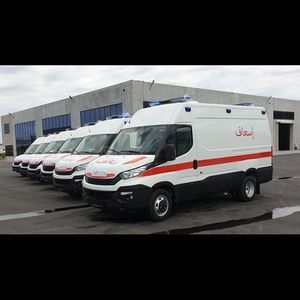
- Primary care
- Emergency medicine, Resuscitation
- Box ambulance
- ICU AUTOMOTIVE IMPORT EXPORT AND CONSULTING.
- Products
- Catalogs
- News & Trends
- Exhibitions
Modular ambulance LC 784x4militarydiesel
Add to favorites
Compare this product
Characteristics
- Configuration
- modular
- Other characteristics
- 4x4, military
- Motor type
- diesel
- Transmission
- manual
- Tare weight
2,800 kg
(6,173 lb)- Total length
4.7 m
(15'05" )- Total width
2 m
(6'06" )- Total height
2.1 m
(6'10" )
Description
Military ambulance is a critical vehicle for providing emergency medical response and evacuation capabilities during military operations. Designed for extreme durability, mobility, and protection, this ambulance allows medical personnel to rapidly reach and extract injured personnel from the front lines.
The LC 78 serves as a mobile treatment center and transport vehicle to quickly move wounded soldiers to higher echelons of care. Key features include armored protection, rugged off-road handling, and onboard medical equipment like stretchers, oxygen, and monitors. This enables the LC 78 to operate close to combat zones, traverse rough terrain, and begin providing medical care immediately at the point of injury.
With capacities between 2 to 6 litter patients, the LC 78 provides flexible transport to match tactical needs. The durable and adaptable design makes the LC 78 an essential component of military medical services across the world. Its capabilities save lives by facilitating rapid casualty response and transport even in the most austere operational environments.
History of Military Ambulances
The use of dedicated ambulances for medical transport originated in military conflict. Horses, carts, and carriages were commandeered to carry wounded soldiers from battlefields as early as ancient times. However, the first organized use of ambulances began during the late 18th and early 19th centuries.
During the Crimean War in the 1850s, the British and French armies deployed horse-drawn carriages specifically designed to transport wounded personnel. These were essentially wooden carts or wagons with suspension designed for rough terrain.
Catalogs
Other ICU AUTOMOTIVE IMPORT EXPORT AND CONSULTING. products
Ambulances
Related Searches
- Stretcher
- First response vehicle
- Non-invasive ventilator
- Emergency stretcher
- Foldable stretcher
- Van first response vehicle
- Mobile health vehicle
- Portable ventilator
- CPAP ventilator
- Emergency ventilator
- Transport ventilator
- Truck mobile health vehicle
- Ambulance with oxygen cylinder
- Box body ambulance
- Stretcher on casters
- Compact ventilator
- Type A ambulance
- Type B ambulance
- Off-road ambulance
- Diesel ambulance
*Prices are pre-tax. They exclude delivery charges and customs duties and do not include additional charges for installation or activation options. Prices are indicative only and may vary by country, with changes to the cost of raw materials and exchange rates.












